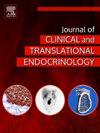青少年肌肉减少型肥胖与前驱糖尿病的关系:2011 - 2016年全国健康与营养调查分析
IF 3.3
Q1 ENDOCRINOLOGY & METABOLISM
Journal of Clinical and Translational Endocrinology
Pub Date : 2025-08-19
DOI:10.1016/j.jcte.2025.100414
引用次数: 0
摘要
目的探讨青少年肌肉减少型肥胖与前驱糖尿病的关系。方法:对美国12-19岁青少年进行横断面回顾性研究。数据来自2011-2012、2013-2014和2015-2016周期的国家健康与营养检查调查(NHANES)。肌肉减少型肥胖被定义为腰围在年龄和性别的第90百分位数或以上,而阑尾骨骼肌质量除以体重低于年龄和性别的后五分位数。结果正常组糖尿病前期患病率为22.2%,肌少症组为15.0%,肥胖组为22.3%,肌少症肥胖组为36.9%。在单因素logistic回归中,与正常组相比,患有肌肉减少型肥胖的青少年患前驱糖尿病的几率更高(优势比= 2.048,95% CI: 1.125-3.728, P = 0.020)。校正混杂因素后,比值仍然显著升高(校正比值比= 2.060,95% CI: 1.178-3.604, P = 0.012)。结论:目前的研究表明,在美国青少年中,肌肉减少型肥胖与前驱糖尿病的发病率增加密切相关。本文章由计算机程序翻译,如有差异,请以英文原文为准。
The relationship between sarcopenic obesity and prediabetes in adolescents: Analysis of the national health and nutrition examination survey from 2011 to 2016
Objective
The purpose of this study was to observe the relationship between sarcopenic obesity and prediabetes in adolescents. Methods: A cross-sectional retrospective study was conducted on United States adolescents aged 12–19 years. Data were extracted from the National Health and Nutrition Examination Survey (NHANES) 2011–2012, 2013–2014, and 2015–2016 cycles. Sarcopenic obesity was defined as waist circumference at or above the 90th percentile for age and sex and appendicular skeletal muscle mass divided by weight below the lower quintile for age and sex.
Results
The prevalence of prediabetes was 22.2 % in the normal group, 15.0 % in the sarcopenia alone group, 22.3 % in the obesity alone group, and 36.9 % in the sarcopenic obesity group. In univariate logistic regression, adolescents with sarcopenic obesity had a higher odds of prediabetes compared to the normal group (odds ratio = 2.048, 95 % CI: 1.125–3.728, P = 0.020). After adjusting for confounders, the odds remained significantly elevated (adjusted odds ratio = 2.060, 95 % CI: 1.178–3.604, P = 0.012).
Conclusion
The present study demonstrates that sarcopenic obesity was closely associated with an increased odds of prediabetes in United States adolescents.
求助全文
通过发布文献求助,成功后即可免费获取论文全文。
去求助
来源期刊

Journal of Clinical and Translational Endocrinology
ENDOCRINOLOGY & METABOLISM-
CiteScore
6.10
自引率
0.00%
发文量
24
审稿时长
16 weeks
 求助内容:
求助内容: 应助结果提醒方式:
应助结果提醒方式:


